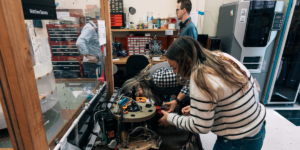
Aaron Falk: SSG PI says system will have built in flexibility
The USC Information Sciences Institute will play the lead role in a NASA project that will use space satellites to deliver data from sensor networks, and then speedily and flexibly structure this data for effective use by scientists. One possibility for early investigation is much more detailed monitoring of microclimates.
Aaron Falk, a project leader in ISI’s computer network division, is principal investigator in the effort. He notes that technology to create networks made up of individual, autonomous sensor units that communicate with each other to monitor the environment has matured in recent years.Falk says the $1.5 million Satellite Sensornet Gateway will bridge a gap that now holds back optimal use of such networks by connecting “local sensornets — which may be broadband, wireless, and populated by many sensors — with satellite networks which, through their long reach, allow data archiving, management, and commanding at a network operations center convenient to the scientist.”
As conceived, SSG will consist of a standard component system that can drop into any local sensornet to communicate between network and satellite. But SSG won’t just collect and store data. Instead, it will all process it to make it easily and transparently accessible anywhere. Moreover, the processing won’t just be a single, pre-set mode:
“A key benefit of our design is its ability to accommodate a broad set of science missions and be rapidly reconfigured as user requirements change.”
And also, promises Falk, the result will be ” a system that does not require the scientist-user to be a communication or software engineer.”
The bottom line: “In-situ sensors will become easier to deploy and manage, expanding their use by Earth scientists.”
Falk’s proposal ticks off the advantages of SSG:
- The gateway is open and extensible because it will have software and hardware interfaces with public specifications and it will have a plug-in, modular software architecture that allows easy extension to new sensors and new communication paths.
- It is flexible because it may support many different sensors, largely independent of the measurements they make, by relying on a common wireless interface.
- It is scalable because the use of wireless interfaces accommodates a large number of sensors.
- It is economical because system development time and cost will be reduced since scientists will not need to design new systems for data backhaul and data aggregation will allow expensive long-haul links to be used more effectively.
The timetable calls for demonstration of a prototype after three years.
SSG builds on the cyberinfrastructure of another ongoing project, the NSF-funded The National Ecological Observatory Network (NEON).
NEON, an NSF Major Research Facilities and Construction Project that may reach $200 million in funding, is planned as continental-size sensor network designed to study the effects of land-use and meteorological changes have on the environment. Hundreds of sensors will be deployed over dozens of sites to measure changes in the air, soil, and water in wildlands and other locations throughout the country.
Falk is leading a 3-year ISI effort to build NEON on-site embedded infrastructure, in addition to the SSG project. A prototype sensor networks NEON created in the James Reserve on Southern California’s San Jacinto mountain range may serve as a testbed for SSG.
SSG will in addition to using information gained developing NEON, like NEON develop a science advisory board. The initial membership will include a member from the NEON board, including Prof. Deborah Estrin, Director of the UCLA Center for Embedded Networked Sensing, and other scientist-researchers who will work with SSG, including Prof. Sassan Saatchi, Senior Scientist at NASA Jet Propulsion Labs; and Mr. Stephen Talabac, Lead Technologist with the Science Data Systems Branch at NASA’s Goddard Space Flight Center.
The SSG project is one of 28 investigations funded by NASA recently under its Advanced Information Systems Technology (AIST) proram.
Published on September 15th, 2006
Last updated on June 6th, 2024









